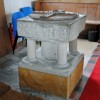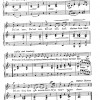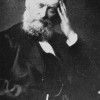Mosaics can be traced as far back as the third millennium BC and were widely applied in Greek and Roman homes of the classical period. They are a pictorial form of enduring decorative ceramic for floors or walls, and demanded considerable skill in their assembling. Until the classical period only coarse pebbles were used, but in the 3rd century BC square, trapezoidal, or triangular glazed tiles or tesserae, varying from a few millimetres to 1 square centimetre in size were introduced.
When Britain became a province of its empire Roman techniques and designs were inevitably imported into the country through growing trade and commercial links with the continent. Mosaic floors were then laid in villas of the civil zone including in Dorset, and several examples of the art have come to light during the excavations of the residences of which they were once a part.
The mosaics found in the Dorset villas were not necessarily contemporary with the original building. A floor could have been laid after many generations of occupation, perhaps at a time of greater status attainment or affluence. Since the floors are usually the only part of the buildings to survive, the mosaics are often all that is known about a villa. But in any event the villas in Dorset seem to date mainly from later in the Roman occupation period, i.e. from the late 3rd century onwards. From the 1st century onwards there appeared a recognised Durnovarian school of mosaicists.
The Durnovarian school was based in Dorchester and at Illchester, now in Somerset but then well within the canton of the Durotriges (the native people of Wessex.) their style is characterised by fine-figured work of common themes and unusual reliefs which point towards a quite restricted cliché or school of expert artisans. The motifs employed are not so much geometric as concentric and were routinely framed by elaborate inter-twinning or guilloche.
While most of the floor would have been laid under the direction of a single mosaicist, there is at least one example of a villa floor in Dorset, which shows traces of completion by another worker of inferior skill to that of his master. There is also evidence to show that parts of some floors were repaired sometime after they were laid. Although more than half a dozen villas are known in Dorset, four in particular have yielded remains of mosaic pavements of sufficient extent to be worthy of conservation and description. These came from Frampton, Hinton St. Mary, Dewlish and Hemsworth.
The villa at Frampton was one of the earliest to be discovered and excavated, in 1796. It was found to have considerably large areas of well-preserved mosaic flooring laid around 350 AD, which were subsequently cleaned and drawn. Here dolphins are a prominent element in the designs, a motif also popular in Christian art. Hinton St. Mary is perhaps the most famous of the villa sites following its fortuitous discovery by the village blacksmith in 1963. As at Frampton virtually all that is known about the villa in through the mosaic, later bought by the British Museum.
But what is most interesting about the floors at both here and Frampton is that they include the earliest yet known icons of Christianity to be found in Britain as well as – and in tandem with – traditional pagan motifs. At both villas the mosaics featured the popular scene of the god Bellerophon slaying the monster Chimaera, as well as other hunting scenes and the popular inclusion of the wine god Bacchus. Yet at Frampton there is also the singular appearance of the Chi-Ro monogram – so called after the first two letters of Christ’s name in Greek (a reverse “P” superimposed on an “X”.)
This monogram appears again in the Hinton flooring, but here it was taken a stage further by the inclusion beneath the symbol of a portrait, which is difficult to interpret as anything other than a likeness of Christ himself. This element of the design appeared to be accorded special status, for it was positioned within an apse or semi-circular embayment seemingly provided for the purpose.
The villa at Dewlish was discovered in the grounds of Dewlish house and found to have almost complete mosaic floors in several rooms. In the entrance passage was a Greek key pattern, while a floral motif bordered by a guilloche with vines adorned the dining room. A room (numbered 11) showed a leopard killing a gazelle. Users of the bath suite changing room would have stood on a design with Cupid, a ram, leopard, dolphin, and a sea creature procession or Theasos. These probably surrounded a centrepiece showing perhaps Neptune, though this detail was missing when excavated, presumed destroyed in antiquity. The leopard and Gazelle fragments were mounted for display in Dewlish House; some of the other pieces went to Dorchester Museum, but the remainder was re-buried.
Excavation of the villa at Hemsworth exposed a fine, complete rhomboidal mosaic laid for the plunge bath in the bath-house. This piece was lifted and presented to Dorchester Museum by the executors of Lord Allington in 1905. In the museum’s conservation section is a roundel of Neptune or Oceanus lifted from the centre of a pavement at Hemsworth in 1908 and presented by the Allington estate executors. This shows the head of a sea-god with crab legs and claws growing from the forehead.
Apart from villa floor sections the County Museum also displays a number of other mosaic fragments discovered during excavations of townhouses around Dorchester, or during the laying of foundations for new buildings. For example a townhouse found in the grounds of the former county hospital yielded a rich 13’x21’ geometric mosaic of rope and diamond patterns in black, white, red, grey, blue and yellow tesserae. This was re-laid in the entrance to a residential home on the site.
In the Victorian Gallery can be seen a fragment from Durngate Street lifted and re-laid in 1905. This shows typical Durnovarian work with crested serpents and leaves similar to a design in the Hinton mosaic in the British Museum. This Durngate piece however is one of the few to show a fruit and leaf motif signature. Also in the gallery is a mosaic unearthed at a site in Olga Rd in 1899. Alfred Pope presented the fragment, which shows a vessel with ornate handles similar to a motif on a Cirencester mosaic, to the museum.
Fordington High Street has yielded a polychromatic mosaic also similar to one at Cirencester, and possibly dating from the 2nd century AD. Found in 1927 it was set up in the temporary exhibition gallery and shows a repair carried out in antiquity to the 3-strand guilloche surrounding one of the circles containing a stylised flower. Six red tesserae of a figure once occupying the central octagon are also present.
A fragment of orange-brown guilloche with flowers can be seen in the Roman Section of the museum. The then Devon and Cornwall Bank (now Natwest) discovered the piece when laying foundations for the new bank. By the main staircase is a fragment of mosaic from near South Street found in 1894 – the first piece to be acquired for the museum by Alfred Pope. Halfway up the staircase a geometric mosaic from the prison burial ground is displayed. It was found in 1858 when a grave for an executed man was being dug and was re-laid in the Prison chapel until that was re-built in 1885, whence it was moved to the museum.
The museum’s entrance lobby is laid with a mosaic made up in 1908 with tesserae from a mosaic surround found behind 45, South Street in 1905. The floor of the Dorchester Townhouse conserved in Colliton Park remained under cover after its excavation between 1937 and 1939 until 1997, when the mosaics were re-exposed and conserved.



